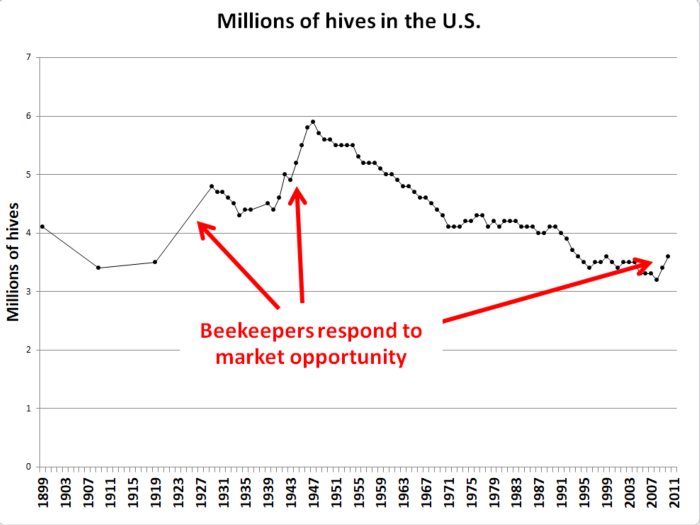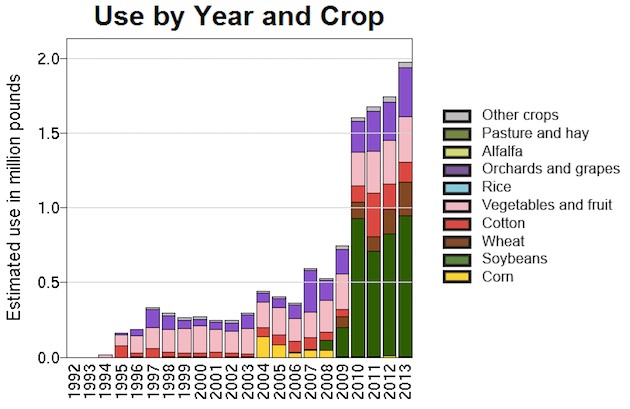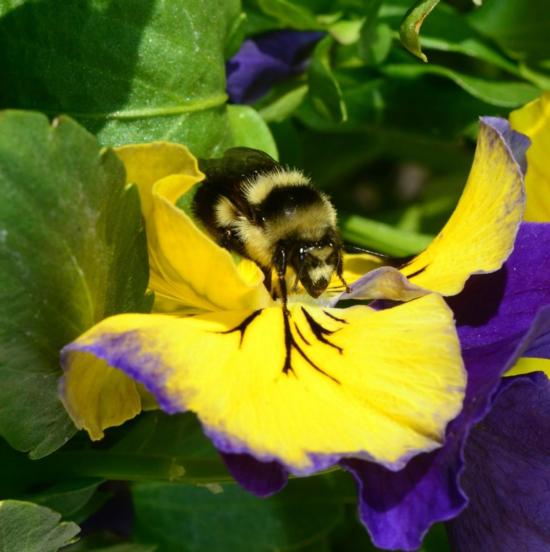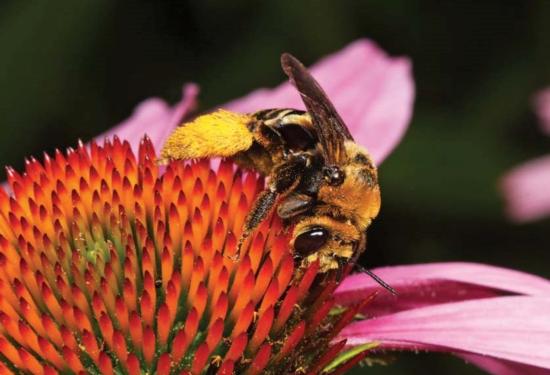Neonicotinoids: An Objective Assessment
by Randy Oliver
Everyone’s heard about the claim that honey bees are going extinct due to the neonicotinoid insecticides. Although I’m glad that folks are concerned about the bees, the fact is that that claim is not accurate.
People have every reason to be concerned about our human impact upon the environment, and many species face extinction due to habitat conversion, pollution, overharvesting and climate change. But the honey bee is not one of them. In actuality, the number of managed hives of bees has been increasing in recent years in nearly every country in the world. Colony numbers reflect the profitability of beekeeping as a business, as reflected in figure 1. The largest number of hives in the United States occurred during World War II due to the Army’s demand for beeswax and the public’s demand for honey. After the War, beekeeping was less profitable, and the number of hives decreased. We then got hit by the introduction of two parasitic mites in the late 1980s, and hive numbers declined further as it became tougher to keep our colonies alive. In recent years, the offered price for hive rental for almond pollination tripled, so colony numbers are on the rise.

Fig. 2. Research efforts to find the cause of elevated rates of colony mortality focused much more on neonicotinoid insecticides than on varroa mites.
Why the Neonics?
Growers have long used insecticides, many of which we now know are not at all environmentally friendly. Since the founding of the EPA in the post Silent Spring era, we are taking a better look at the impacts of pesticides upon off-target organisms, the environmental fates of the products and their long-term sublethal effects — especially upon humans. EPA has thus phased out the “Dirty Dozen” persistent organic pollutants (POPs) and in recent years has revoked or restricted the use of a number of others. For example, the previously commonly-used organophosphate chlorpyrifos is no longer registered for use as a household bug spray.
The problem is that as we limit the number of insecticides available to growers, pests develop resistance to regularly-applied products. Additionally, the largest portion of a sprayed insecticide never actually hits the intended pest — thus ending up in the air and water, and in the rest of the environment. Growers thus put pressure on the chemical companies to continually develop new types of pesticides, while the consumer demands safer products.
Enter the Neonicotinoids
The neonicotinoids (meaning new, nicotine-like) are synthetic derivatives of the natural plant alkaloid nicotine. The neonics affect specific receptors in the nervous system of insects that are less prevalent in vertebrate animals, so they are thus much safer for humans, other mammals, birds and fish. In fact, the most commonly-used neonic, imidicloprid, is less toxic to humans than is caffeine.
The second advantage of the neonics is that they are systemic — they can be absorbed through a plant’s roots and get carried via the xylem to the rest of the plant (editor’s note: see Jim Bethke’s feature article for more information about the movement of systemic pesticides such as neonicotinoids in plants). Thus, if they are applied as a seed treatment, the only organisms exposed to the chemical are the pests that take a bite out of the plant, or consume the pollen or nectar (this is where bees enter the picture). Because of these advantages, neonics quickly became the most widely-used insecticides in the United States (fig. 3) and in the world.

Effects of Neonics on Bees
Neonics are ideally applied as seed treatments, where the amount per seed can be carefully controlled, so that by the time that a plant produces nectar and pollen, the residues are too diluted to harm pollinators. Unfortunately, during the introduction of the neonics, there were some serious incidents of inadvertent bee kills when the seed coating rubbed off in pneumatic seed planters, and the dust killed bees. In most countries, this issue has now been resolved.
This leaves the question of neonic residues in nectar and pollen. In general, the residues in the nectar and pollen of properly-treated agricultural crops (typically less than 3 ppb) do not appear to cause significant adverse effects on honey bee colonies. I’ve personally visited beekeepers in corn, soy and canola growing areas, and they report that with the introduction of Bt genetically-engineered crops and the use of neonic seed treatments, that the pesticide issues that they suffered from in the 1960s and ‘70s have largely gone away. That said…
The Neonics Are Not Without Problems
Insecticides by definition are designed to kill insects. No insecticide is environmentally
harmless, and as we learn more about unintended effects, our regulators must revise the approved allowable applications. We have now found that the honey bee colony is a special case, and it is able to “buffer” the sublethal effects of the neonics on the colony. Despite clear adverse effects on individual workers, the net result to the colony is generally minimal. However, although properly-applied neonics appear to generally cause minimal measurable adverse effects on honey bee colonies, they may have more deleterious effects upon bumblebees (fig. 4) and solitary native bees (fig. 5). This is a serious concern, of which the EPA is well aware.

 |
Fig. 5. A female solitary bee (Svasta obliqua expurgata) on purple coneflower (Echinacea pupurea). Source: Frankie G, Thorp R, Hernandez J, Rizzardi M, Ertter B, Pawelek J, Witt S, Schindler M, Coville R, Wojcik V. 2009. Native bees are a rich natural resource in urban California gardens. Calif Agr 63(3):113-120. https://doi.org/10.3733/ca.v063n03p113.
Another concern is that especially with the widespread prophylactic use of neonic seed treatment, more and more residues are ending up at agricultural field margins and in aquatic ecosystems (fig. 6). Certain uncultivated plants in the field margins concentrate neonic residues in their nectar and/or pollen. For example, a study in Saskatchewan found residues up to 20 ppb in some flowers — enough to start causing problems in bee hives (serious problems occur at 50 ppb), and strong adverse effects upon some native pollinators. These unintended effects upon native pollinators and aquatic invertebrates need to be addressed, and the universal use of treated seed should be restricted.

Uses Other than as Seed Treatments
Neonics can also be applied as sprays, drenches, or other foliar applications, or by chemigation. There is far more room for misapplication by these methods. And perhaps worst of all would be misapplication by homeowners, who may think that “if a little is good, more might be better.” Luckily, in the studies I’ve seen, urban and suburban bee-collected pollen and nectar normally does not contain toxic levels of neonics.
And this brings us to neonic applications in nursery stock. In order to ship stock across state lines, nurseries must produce pest-free plants. This requires insecticides. But nursery managers do not want to expose employees and customers to residues of organophosphates such as chlorpyrifos. They can avoid this by placing a measured amount of a neonic in the potting soil, which then, due to its systemic action, results in “clean” plants, and no human-harmful residues. Ideally, by the time a pollinator-attractive plant produces flowers, the residues would be diluted enough so as not to cause harm. None-the-less, some consumer activists claim that plants treated with neonics are harmful to bees and advocate boycotts of plants sold at big box nurseries (see https://www.facebook.com/GMOFreeUSA/photos/a.468695639837571.108816.402058139834655/1195524787154649/?type=3). The problem is, that no one has individually tested the thousands of cultivars of nursery plants for residues of imidacloprid in the flowers at time of sale.
Jim Bethke and I are currently involved in an IR-4 Project at Rutgers University to investigate the concentration of systemic pesticides in pollen and nectar and determine whether residues exceed safe levels with current ornamental horticulture production practices (Editor’s note: Elina Niño is also working on this grant; she provides a link to the USDA 2016 Specialty Crop Research and Extension Investments (SCRI) project, funded through USDA’S National Institute of Food and Agriculture (NIFA), which was awarded to the IR-4 Project’s Ornamental Horticulture Program based at Rutgers.) Currently, we can’t really say which nursery plants might be problematic for pollinators. However, nursery growers can generally check a garden book to see if a cultivar is attractive to bees or butterflies; if so, at this time they may wish to avoid treating pollinator-attractive potted plants with neonicotinoids to be on the safe side and avoid controversy. (Editor’s note: also see Elina Niño’s feature article for a link to a list of pollinator-attractive plants.)
Wrap Up
No insecticide is harmless. All of agriculture should shift towards integrated pest management practices to reduce reliance upon pesticides. California is the most proactive state in the Nation as far as safe pesticide use. The ag community and chemical companies have gotten the message loud and clear that the consumer wants them to reduce pesticide use and develop more eco-friendly pesticides — both of which they are doing.
Growing “organic” may help, but the best future will be the adoption of agro-ecology, which goes beyond “certified organic.” The field of agroecology is based upon biology, soil improvement and sustainability, rather than arbitrary rules that exclude precision breeding and environmentally-friendly synthetic pesticides, fertilizers and practices. Keep in mind that it is the consumer who can affect the most rapid change—even the largest agribusinesses respond immediately to consumer demand. (Editor’s note: see Richard Evan’s “Science to the Grower” article on consumer preference and pollinator-friendly nursery products.)
Randy Oliver is the owner of Golden West Bees in Northern California which provides migratory pollination services for almonds and produces nucleus colonies (nucs) and honey for sale. But he is much more widely known as the voice of the ScientificBeekeeping.com website, at which he interprets scientific research for the benefit of the beekeeping community.
More Reading
http://scientificbeekeeping.com/the-extinction-of-the-honey-bee/
http://scientificbeekeeping.com/neonicotinoids-trying-to-make-sense-of-the-science/
http://scientificbeekeeping.com/neonicotinoids-trying-to-make-sense-of-the-science-part-2/












